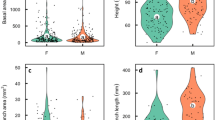Abstract
Floral sex allocation (weight of male flower buds over weight of female flower buds) was examined at the levels of current-year shoot, individual tree and population, and the tree individual level and population level floral sex ratio was explained as a consequence of the behavior of current-year shoots in the shoot-level monoecious (flowering current-year shoots have both male and female flowers) species, Siberian alder (Alnus hirsuta var. sibirica). The current-year shoot level floral sex allocation was not size-dependent and not different over years. However, in the year when the reproductive intensity was high, individual tree level floral sex allocation was size-dependent and the population level floral sex allocation was relatively female-biased. The female-biased floral sex allocation at the population level resulted from many gynoecious shoots (current-year shoots which have only female flowers). These results suggest that the floral sex allocation of Siberian alder was controlled not by changing the floral sex allocation of each current-year shoot, but by shifting the sex expression of current-year shoots from shoot-level monoecy to shoot-level gynomonoecy.





Similar content being viewed by others
References
Ashman TL, Baker I (1992) Variation in floral sex allocation with time of season and currency. Ecology 73:1237–1243
Charlesworth D, Charlesworth B (1981) Allocation of resources to male and female functions in hermaphrodites. Biol J Linn Soc 15:57–74
Charnov EL (1979) The genetical evolution of patterns of sexuality: Darwinian fitness. Am Nat 113:465–480
Charnov EL (1982) The theory of sex allocation. Princeton University Press, Princeton
Charnov EL, Maynard Smith J, Bull JJ (1976) Why be an hermaphrodite? Nature 263:125–126
Cox PA (1988) Monomorphic and dimorphic sexual strategies: a modular approach. In: Lovett Doust J, Lovett Doust L (eds) Plant reproductive ecology: patterns and strategies. Oxford University Press, Oxford, pp 80–97
Fisher RA (1958) The genetic theory of natural selection (2nd revision). Dover, New York
Hasegawa S, Takeda H (2001) Functional specialization of current shoots as a reproductive strategy in Japanese alder (Alnus hirsuta var. sibirica). Can J Bot 79:38–48
Hasegawa S, Koba K, Tayasu I, Takeda H, Haga H (2003) Carbon autonomy of reproductive shoots of Siberian alder (Alnus hirsuta var. sibirica). J Plant Res 116:183–188
Henriksson J (2001) Differential shading of branches or whole trees: survival, growth and reproduction. Oecologia 126:482–486
Klinkhamer GL, de Jong TJ (1997) Size-dependent allocation to male and female reproduction. In: Bazzaz FA, Grace J (eds) Plant resource allocation. Academic, London, pp 211–229
Lloyd DG (1983) Evolutionarily stable sex ratios and sex allocations. J Theor Biol 105:525–539
Lloyd DG (1984) Gender allocations in outcrossing cosexual plants. In: Dirzo R, Sarukhán J (eds) Perspectives on plant population ecology. Sinauer, Sunderland, pp 277–300
Méndez M (2001) Sexual mass allocation in species with inflorescences as pollination units: a comparison between Arum italicum and Arisaema (Araceae). Am J Bot 88:1781–1785
Murai S (1963) Phylotaxonomical and geobotanical studies on so called genus Alnus in Japan (II). Comparative studies on all species, including shrubby species (in Japanese with English summary). Bull Gov For Exp Station Jpn 154:19–71
Newell EA (1991) Direct and delayed costs of reproduction in Aesculus californica. J Ecol 79:365–378
Nilsson SG, Wästljung U (1987) Seed predation and cross-pollination in mast-seeding beech Fagus sylvatica patches. Ecology 68:260–265
Obeso JR (1997) Costs of reproduction in Ilex aquifolium: effects at tree, branch and leaf levels. J Ecol 85:159–166
Room PM, Maillette L, Hanan JS (1994) Module and metamer dynamics and virtual plants. Adv Ecol Res 25:105–157
Ruohomäki K, Haukioja E, Repka S, Lehtilä K (1997) Leaf value: effects of damage to individual leaves on growth and reproduction of mountain birch shoots. Ecology 78:2105–2117
Sork VL, Bramble J, Sexton O (1993) Ecology of mast-fruiting in three species of North American deciduous oaks. Ecology 74:528–541
Tuomi J, Vuorisalo T (1989) What are the units of selection in modular organisms? Oikos 54:227–233
Tuomi J, Niemel P, Mannila R (1982) Resource allocation on dwarf shoots of birch (Betula pendula): reproduction and leaf growth. New Phytol 91:483–487
Tuomi J, Vuorisalo T, Niemelä P, Nisula S, Jormalainen V (1988) Localized effects of branch defoliations on weight gain of female inflorescences in Betula pubescens. Oikos 51:327–330
Tuomi J, Vuorisalo T, Niemelä P, Haukioja E (1989) Effects of localized defoliations on female inflorescences in mountain birch, Betula pubescens ssp. tortuosa. Can J Bot 67:334–338
Watson MA, Casper BB (1984) Morphological constraints on patterns of carbon distribution in plants. Annu Rev Ecol Syst 15:233–258
White J (1979) The plant as a metapopulation. Annu Rev Ecol Syst 10:109–145
Willson MF (1983) Plant reproductive ecology. Wiley, New York
Yamaguchi Y (1985) Sex ratios of an aphid subject to local mate competition with variable maternal condition. Nature 318:460–462
Acknowledgments
We acknowledge T. Ando, K. Kurumado, N. Miyamoto, A. Mori, H. Tobita and all the staff of Takayama Research Station, Institute for Basin Ecosystem Studies, Gifu University for the support of field studies. We are grateful to H. Barclay, E. Ito and M. Suzuki for reading through the manuscript and for giving us valuable suggestions. We also acknowledge S. Nanami, T. Shirota, K. Kikuzawa, T. Kohyama and the members of Laboratory of Regional Ecosystems, Graduate School of Environmental Earth Science, Hokkaido University for their valuable advice.
Author information
Authors and Affiliations
Corresponding author
Rights and permissions
About this article
Cite this article
Hasegawa, S.F., Takeda, H. Behavior of current-year shoots as a mechanism to determine the floral sex allocation at the level of individual tree and population in Siberian alder (Alnus hirsuta var. sibirica). Trees 19, 26–31 (2005). https://doi.org/10.1007/s00468-004-0359-2
Received:
Accepted:
Published:
Issue Date:
DOI: https://doi.org/10.1007/s00468-004-0359-2




